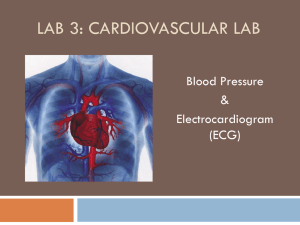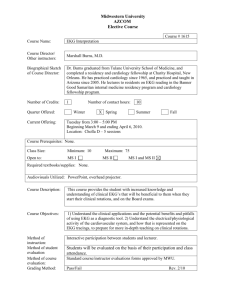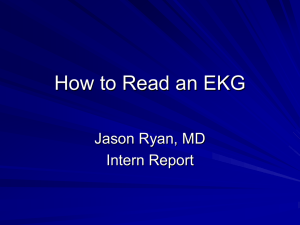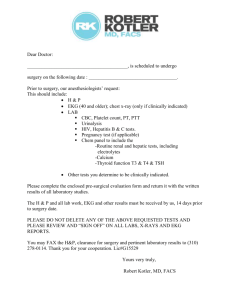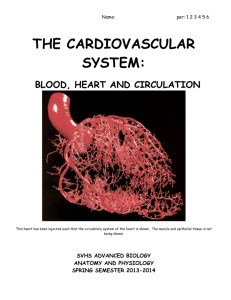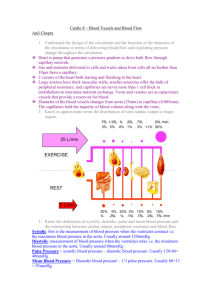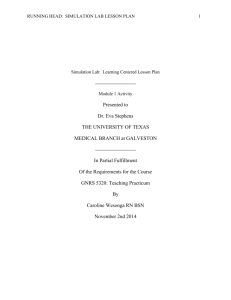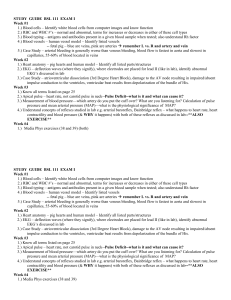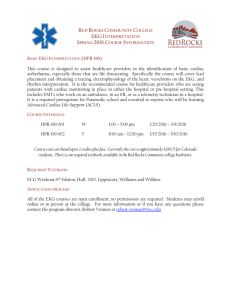Lab 3 – The Mammalian Cardiovascular System
advertisement
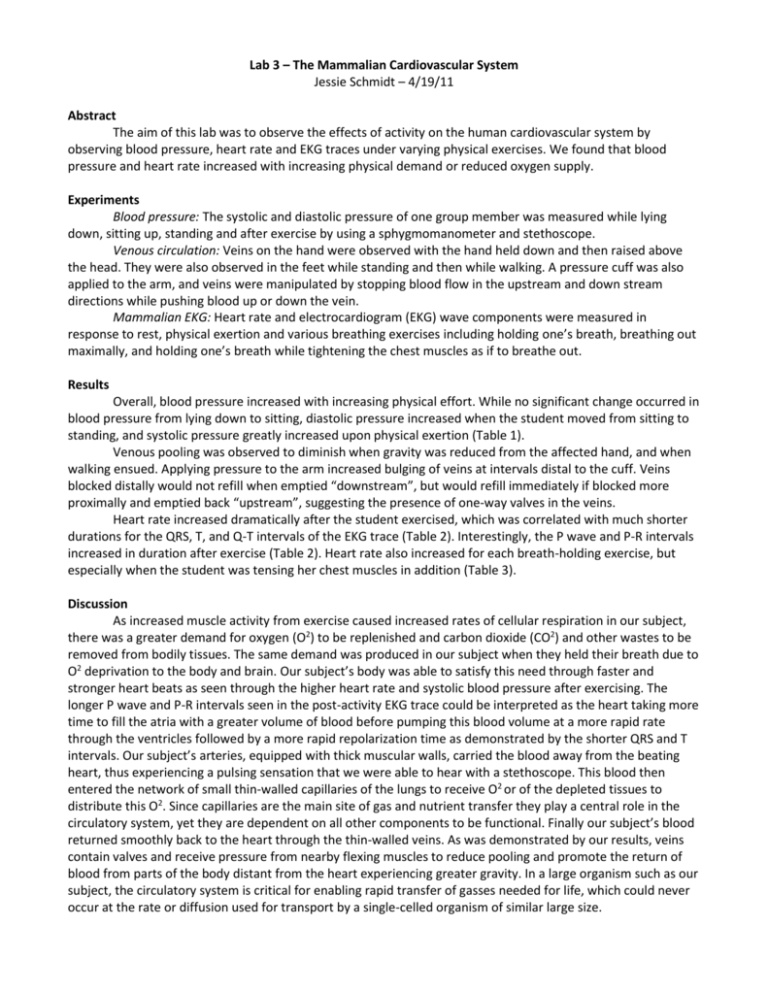
Lab 3 – The Mammalian Cardiovascular System Jessie Schmidt – 4/19/11 Abstract The aim of this lab was to observe the effects of activity on the human cardiovascular system by observing blood pressure, heart rate and EKG traces under varying physical exercises. We found that blood pressure and heart rate increased with increasing physical demand or reduced oxygen supply. Experiments Blood pressure: The systolic and diastolic pressure of one group member was measured while lying down, sitting up, standing and after exercise by using a sphygmomanometer and stethoscope. Venous circulation: Veins on the hand were observed with the hand held down and then raised above the head. They were also observed in the feet while standing and then while walking. A pressure cuff was also applied to the arm, and veins were manipulated by stopping blood flow in the upstream and down stream directions while pushing blood up or down the vein. Mammalian EKG: Heart rate and electrocardiogram (EKG) wave components were measured in response to rest, physical exertion and various breathing exercises including holding one’s breath, breathing out maximally, and holding one’s breath while tightening the chest muscles as if to breathe out. Results Overall, blood pressure increased with increasing physical effort. While no significant change occurred in blood pressure from lying down to sitting, diastolic pressure increased when the student moved from sitting to standing, and systolic pressure greatly increased upon physical exertion (Table 1). Venous pooling was observed to diminish when gravity was reduced from the affected hand, and when walking ensued. Applying pressure to the arm increased bulging of veins at intervals distal to the cuff. Veins blocked distally would not refill when emptied “downstream”, but would refill immediately if blocked more proximally and emptied back “upstream”, suggesting the presence of one-way valves in the veins. Heart rate increased dramatically after the student exercised, which was correlated with much shorter durations for the QRS, T, and Q-T intervals of the EKG trace (Table 2). Interestingly, the P wave and P-R intervals increased in duration after exercise (Table 2). Heart rate also increased for each breath-holding exercise, but especially when the student was tensing her chest muscles in addition (Table 3). Discussion As increased muscle activity from exercise caused increased rates of cellular respiration in our subject, there was a greater demand for oxygen (O2) to be replenished and carbon dioxide (CO2) and other wastes to be removed from bodily tissues. The same demand was produced in our subject when they held their breath due to O2 deprivation to the body and brain. Our subject’s body was able to satisfy this need through faster and stronger heart beats as seen through the higher heart rate and systolic blood pressure after exercising. The longer P wave and P-R intervals seen in the post-activity EKG trace could be interpreted as the heart taking more time to fill the atria with a greater volume of blood before pumping this blood volume at a more rapid rate through the ventricles followed by a more rapid repolarization time as demonstrated by the shorter QRS and T intervals. Our subject’s arteries, equipped with thick muscular walls, carried the blood away from the beating heart, thus experiencing a pulsing sensation that we were able to hear with a stethoscope. This blood then entered the network of small thin-walled capillaries of the lungs to receive O2 or of the depleted tissues to distribute this O2. Since capillaries are the main site of gas and nutrient transfer they play a central role in the circulatory system, yet they are dependent on all other components to be functional. Finally our subject’s blood returned smoothly back to the heart through the thin-walled veins. As was demonstrated by our results, veins contain valves and receive pressure from nearby flexing muscles to reduce pooling and promote the return of blood from parts of the body distant from the heart experiencing greater gravity. In a large organism such as our subject, the circulatory system is critical for enabling rapid transfer of gasses needed for life, which could never occur at the rate or diffusion used for transport by a single-celled organism of similar large size. Table 1. Average blood pressure of a BI-253 student based on three trials for each activity. Average pressure (mmHg) Lying down Sitting Standing Post Activity Systolic 115 117 110 123 Diastolic 71 73 81 85 Table 2. Effects of exercise on the EKG wave form and heart rate of a BI-253 student. EKG wave segment duration (s) Heart Rate (beats/min) Activity P R T QRS P-R Q-T Resting 0.09 0.21 0.30 0.24 0.09 0.30 68 Post activity 0.11 0.16 0.19 0.18 0.11 0.19 131 Table 3. Effects of breathing manipulations on the heart rate of a BI-253 student. Heart Rate (beats/min) Breathing test Before test During test Hold Inspiration 69 77 Expiration and Hold 62 72 Hold Inspiration while tensing 65 80
